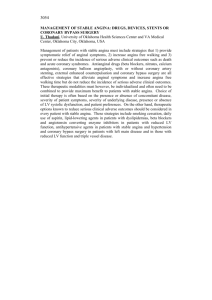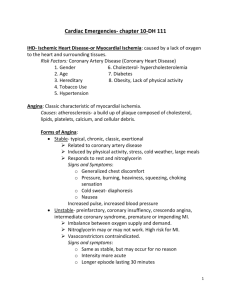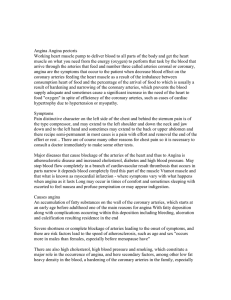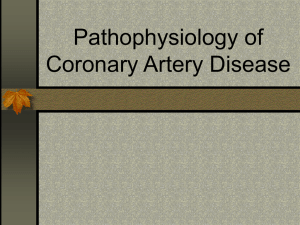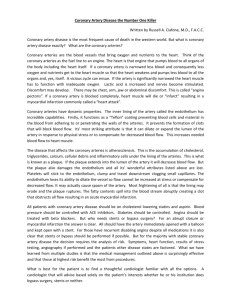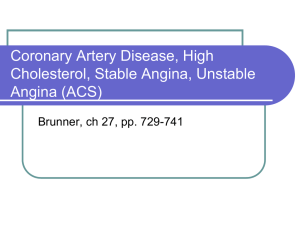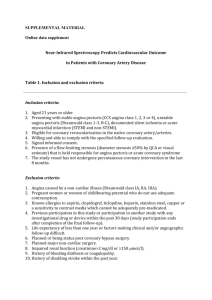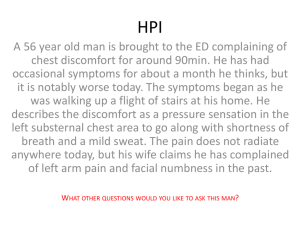Angina: A guide for patients
advertisement
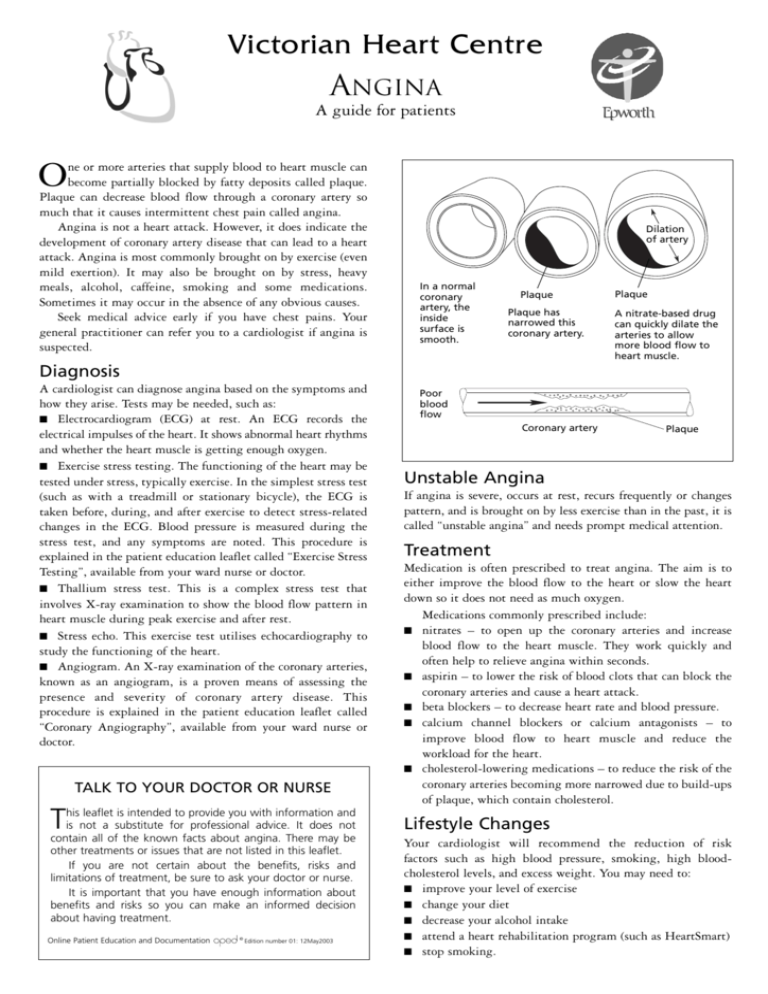
Victorian Heart Centre ANGINA A guide for patients O ne or more arteries that supply blood to heart muscle can become partially blocked by fatty deposits called plaque. Plaque can decrease blood flow through a coronary artery so much that it causes intermittent chest pain called angina. Angina is not a heart attack. However, it does indicate the development of coronary artery disease that can lead to a heart attack. Angina is most commonly brought on by exercise (even mild exertion). It may also be brought on by stress, heavy meals, alcohol, caffeine, smoking and some medications. Sometimes it may occur in the absence of any obvious causes. Seek medical advice early if you have chest pains. Your general practitioner can refer you to a cardiologist if angina is suspected. Dilation of artery In a normal coronary artery, the inside surface is smooth. Plaque Plaque has narrowed this coronary artery. Plaque A nitrate-based drug can quickly dilate the arteries to allow more blood flow to heart muscle. Diagnosis A cardiologist can diagnose angina based on the symptoms and how they arise. Tests may be needed, such as: ■ Electrocardiogram (ECG) at rest. An ECG records the electrical impulses of the heart. It shows abnormal heart rhythms and whether the heart muscle is getting enough oxygen. ■ Exercise stress testing. The functioning of the heart may be tested under stress, typically exercise. In the simplest stress test (such as with a treadmill or stationary bicycle), the ECG is taken before, during, and after exercise to detect stress-related changes in the ECG. Blood pressure is measured during the stress test, and any symptoms are noted. This procedure is explained in the patient education leaflet called “Exercise Stress Testing”, available from your ward nurse or doctor. ■ Thallium stress test. This is a complex stress test that involves X-ray examination to show the blood flow pattern in heart muscle during peak exercise and after rest. ■ Stress echo. This exercise test utilises echocardiography to study the functioning of the heart. ■ Angiogram. An X-ray examination of the coronary arteries, known as an angiogram, is a proven means of assessing the presence and severity of coronary artery disease. This procedure is explained in the patient education leaflet called “Coronary Angiography”, available from your ward nurse or doctor. TALK TO YOUR DOCTOR OR NURSE T his leaflet is intended to provide you with information and is not a substitute for professional advice. It does not contain all of the known facts about angina. There may be other treatments or issues that are not listed in this leaflet. If you are not certain about the benefits, risks and limitations of treatment, be sure to ask your doctor or nurse. It is important that you have enough information about benefits and risks so you can make an informed decision about having treatment. Online Patient Education and Documentation © Edition number 01: 12May2003 Poor blood flow Coronary artery Plaque Unstable Angina If angina is severe, occurs at rest, recurs frequently or changes pattern, and is brought on by less exercise than in the past, it is called “unstable angina” and needs prompt medical attention. Treatment Medication is often prescribed to treat angina. The aim is to either improve the blood flow to the heart or slow the heart down so it does not need as much oxygen. Medications commonly prescribed include: ■ nitrates – to open up the coronary arteries and increase blood flow to the heart muscle. They work quickly and often help to relieve angina within seconds. ■ aspirin – to lower the risk of blood clots that can block the coronary arteries and cause a heart attack. ■ beta blockers – to decrease heart rate and blood pressure. ■ calcium channel blockers or calcium antagonists – to improve blood flow to heart muscle and reduce the workload for the heart. ■ cholesterol-lowering medications – to reduce the risk of the coronary arteries becoming more narrowed due to build-ups of plaque, which contain cholesterol. Lifestyle Changes Your cardiologist will recommend the reduction of risk factors such as high blood pressure, smoking, high bloodcholesterol levels, and excess weight. You may need to: ■ improve your level of exercise ■ change your diet ■ decrease your alcohol intake ■ attend a heart rehabilitation program (such as HeartSmart) ■ stop smoking.

